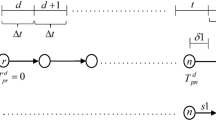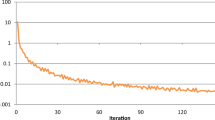Abstract
In this study, we examine Braess’ paradox in the context of a Stochastic Transportation Network Design Problem (NDP). In conventional NDPs, major variables such as link travel time and traffic flows are considered to be deterministic. However, in the real world, due to variations in traffic patterns, travelers experience different travel times. To account for this variation, in this study Monte Carlo simulation is employed to incorporate the probabilistic nature of travel demand. A new objective function for the NDP is formulated based on the probabilistic definition of link flows, and the design results are compared with the results obtained from conventional formulations. This new model is used to analyze Braess’ paradox, a well-known counter intuitive network phenomenon. Our results indicate that Braess’ paradox is more likely to be observed in our model, as there are more uncertainties in travel demand.
Similar content being viewed by others
References
Abdulaal, M. and LeBlanc, L. J. (1979). “Continuous equilibrium network design models.” Transp. Res. Part B, Vol. 13, No. 1, pp. 19–32, DOI: 10.1016/0191-2615(79)90004-3.
Asakura, Y. and Hato, E. (2001). “A route recognition model for transport network reliability analysis.” Edited by Bell, M. G. H. and Cassir, C. (Eds.), Reliability of Transport Networks, pp. 203–216, Research Study Press.
Braess, D., Nagurney, A., and Wakolbinger, T. (2005). “On a paradox of traffic planning.” Transp. Sci., Vol. 39, No. 4, pp. 446–450. (Translated from original German: D., Braess, “Über ein Paradoxon aus der Verkehrsplanung.” Unternehmensforschung, Vol. 12, pp. 258–268 (1968), DOI 10.1287/trsc.1050.0127.
Chen, A. and Xu, X. (2012). “Goal programming approach to solving the network design problem with multiple objectives and demand uncertainty.” Expert Systems with Applications, Vol. 39, No. 4, pp. 4160–4170.
Chen, A. and Yang, C. (2004). “Stochastic transportation network design problem with spatial equity constraint.” Transportation Research Record, No. 1882, pp. 97–104.
Chen, A., Chootinan, P., and Wong, S. C. (2006). “New reserve capacity model of a signal-controlled road network.” Transportation Research Record, No. 1964, pp. 35–41.
Chen, A., Kim, J., Lee, S., and Kim, Y. (2010). “Stochastic multi-objective models for network design problem.” Expert systems with applications, Vol. 37, No. 2, 1608–1619, DOI: 10.1016/j.eswa.2009. 06.048.
Chen, A., Kim, J., Zhou, Z., and Chootinan, P. (2007). “Alpha reliable network design problem.” Transportation Research Record, No. 2029, pp. 49–57.
Chen, A., Subprasom, K., and Ji, Z. W. (2003). “Mean-Variance model for the Build-Operate-Transfer scheme under demand uncertainty.” Transportation Research Record., No. 1857, pp. 93–101, DOI: 10.3141/1857-11.
Chen, A., Yang, H., Lo, H. K., and Tang, W. H. (2002). “Capacity reliability of a road network: An assessment methodology and numerical results.” Transp. Res. Part B, Vol. 36, No. 3, pp. 225–252, DOI: 10.1016/S0191-2615(00)00048-5.
Chen, A., Zhou, Z., Chootinan, P., Ryu, S., Yang, C., and Wong, S. C. (2011). “Transport network design problem under uncertainty: A review and new developments.” Transport Reviews, 2011, Vol. 31, No. 6, pp. 743–768.
Chootinan, P., Wong, S. C., and Chen, A. (2005). “A reliability-based network design problem.” Journal of Advanced Transportation, Vol. 39, No. 3, pp. 247–270.
Clark, S. D. and Watling, D. P. (2005). “Modeling network travel time reliability under stochastic demand.” Transp. Res. Part B, Vol. 39, No. 2, pp. 119–140, DOI: 10.1016/j.trb.2003.10.006.
Harker, P. T. and Friesz, T. L. (1986). “Prediction of intercity freight flows, I: Theory.” Transportation Research Part B: Methodological, Vol. 20, No. 2, pp. 139–153.
Hazelton, M. L. (2003). “Some comments on origin-destination matrix estimation.” Transp. Res. Part A, Vol. 37, No. 10, pp. 811–822, DOI: 10.1016/S0965-8564(03)00044-2.
Kim, H. (2008). “New dynamic travel demand modeling methods in advanced data collecting environments.” Ph.D. dissertation, Univ. of California, Irvine.
Kim, H. and Lim, Y. (2012). “A day-to-day route choice model based on driver’s past experience.” KSCE Journal of Civil Engineering, Vol. 16, No. 7, pp. 1267–1279, DOI: 10.1007/s12205-012-1285-2.
Lam, W. H. K., Shao, H., and Sumalee, A. (2008). “Modeling impacts of adverse weather conditions on a road network with uncertainties in demand and supply.” Transp. Res. Part B, Vol. 42, No. 10, pp. 890–910, DOI: 10.1016/j.trb.2008.02.004.
Lee, S., Moon, B., and Asakura, Y. (2000). “Reliability analysis and calculation on large scale transport networks.” Edited by Bell, M.G.H. and Cassir, C. (Eds.), Reliability of Transport Networks, pp 173–190, Research Study Press.
Lo, H. K. and Tung, Y. K. (2003). “Network with degradable links: Capacity analysis and design.” Transp. Res. Part B, Vol. 37, No. 4, pp. 345–363, DOI: 10.1016/S0191-2615(02)00017-6.
Oh, T., Kim, H., and Park, D. (2011). “Bi-objective network optimization for spatial and temporal coordination of multiple highway construction projects.” KSCE Journal of Civil Engineering, Vol. 15, No. 8, pp. 1449–1455, DOI: 10.1007/s12205-011-1428-x.
Pas, E. I. and Principio, S. L. (1997). “Braess’ Paradox: some new insights.” Transp. Res. Part B, Vol. 31, No. 3, pp. 265–276, DOI: 10.1016/S0191-2615(96)00024-0.
Prashker, J. N. and Bekhor, S. (2000). “Some observations on stochastic user equilibrium and system optimum of traffic assignment.” Transp. Res. Part B, Vol. 34, No. 4, pp. 277–291, DOI: 10.1016/S0191-2615(99)00025-9.
Ryu, S., Chen, A., and Kim, Y. (2013). “Investigating travel time reliability measures in toll design problem.” Asian Transport Studies, Vol. 2, No. 3, pp. 253–268.
Sheffi, Y. and Daganzo, C. F. (1978). “Another “paradox” of traffic flow.” Transp. Res., Vol. 12, No. 1, pp. 43–46, DOI: 10.1016/0041-1647(78)90106-5.
Siu, B. W. Y. and Lo, H. K. (2008). “Doubly uncertain transportation network: Degradable capacity and stochastic demand.” Eur. Oper. Res., Vol. 191, No. 1, pp. 166–181, DOI:10.1016/j.ejor.2007.08.026.
Sumalee, A., Watling, D. P., and Nakayama, S. (2006). “Reliable network design problem: The case with stochastic demand and total travel time reliability.” Transp. Res. Rec., Vol. 1964, pp. 81–90, DOI: 10.3141/1964-10.
Suwansirikul, C., Friesz, T. L., and Tobin, R. L. (1987). “Equilibrium decomposed optimization: A heuristic for the continuous equilibrium network design problem.” Transp. Sci., Vol. 21, No. 4, pp. 254–263, DOI: 10.1287/TRSC.21.4.254.
Ukkusuri, S. V., Mathew, T. V., and Waller S. T. (2007). “Robust transportation network design under demand uncertainty.” Comput. Aided Civ. Infrastruct. Eng., Vol. 22, pp. 6–18, DOI: 10.1111/j.1467-8667.2006.00465.x.
Waller, S. T., Schofer, J. L., and Ziliaskopoulos, A. K. (2001). “Evaluation with traffic assignment under demand uncertainty.” J. Transp. Res. Board, Vol. 1771, pp. 69–74, DOI: 10.3141/1771-09.
Xu, X., Chen, A., and Cheng, L. (2013). “Stochastic network design problem with fuzzy goals.” Transportation Research Record, No. 2399, pp. 23–33.
Yang, H. and Bell, M. G. H. (1998). “Models and algorithms for road network design: A review and some new developments.” Transportation, Vol. 18, No. 3, pp. 257–278, DOI: 10.1080/01441649808717016.
Yao, J. and Chen, A. (2014). “An analysis of logit and weibit route choices in stochastic assignment paradox.” Transportation Research Part B, Vol. 69, No. 1, pp. 31–49.
Yim, K., Wong, S. C., Chen, A., Wong, C. K., and Lam, W. H. K. (2011). “A reliability-based land use and transportation optimization model.” Transportation Research Part C, Vol. 19, No. 2, pp. 351–362.
Author information
Authors and Affiliations
Corresponding author
Rights and permissions
About this article
Cite this article
Tiratanapakhom, T., Kim, H., Nam, D. et al. Braess’ paradox in the uncertain demand and congestion assumed Stochastic Transportation Network Design Problem. KSCE J Civ Eng 20, 2928–2937 (2016). https://doi.org/10.1007/s12205-016-0265-3
Received:
Accepted:
Published:
Issue Date:
DOI: https://doi.org/10.1007/s12205-016-0265-3




